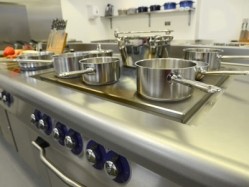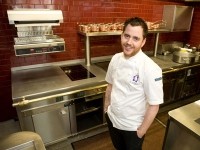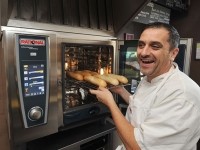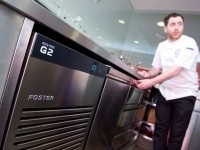Equipping your kitchen: How to work with the space you've got

With restaurant sites becoming ever harder to find and competition for the best and largest ones increasing, many chefs and restaurant operators are being forced to be creative when it comes to choosing the venue where they can make their business dreams come true.
Sometimes this means they accept smaller than desired sites or those with less-practical lay-outs.
So, if this applies to you, how do you go about kitting out your kitchen so you don’t have to compromise your vision and still deliver quality food to your customers?
Former Fifth Floor restaurant chef Jonas Karlsson took over neighbourhood restaurant Wine and Mousaka last year for his first solo venture Linnea. Having operated as a restaurant previously the building evidently included a kitchen, but Karlsson had firm ideas of what he wanted and decided to start from scratch.
Ask for help
The Swedish-born chef employed Dawson Design Projects to help him design his kitchen and find the best equipment to meet his needs, budget and fit the space. He says he had clear ideas of what he needed, but as the 18 square metre kitchen he had to equip was considerably smaller than those he’d been used to he felt he needed help to get the most out of it.

“I knew what I wanted, but I decided to get the help of professionals,” he says. “It’s important to have a kitchen designer who has worked with other businesses in the industry and Dawson Design has a lot of experience in this area.”
Karlsson ended up with a gas cooker and combi oven from Italian company Olis, a commercial dishwasher, Pacojet and a selection of blenders.
He chose the equipment based on Dawson Design Projects’ recommendation and that fact that it was ‘good quality, but not too expensive’.
Karlsson also believes that having a smaller kitchen as well as it being his own restaurant made him pay extra attention at the start, a top tip he wants to share with others in a similar situation.
“I would say to others doing the same, plan well and get everything you need at the start, because once you open you’ll have so many other things to think about you won’t have time to change your kitchen,” he says.
Now, three months on the chef remains happy with his decision and says, save the purchase of a few extra ‘gadgets’, he would not change a thing.
“I also think it’s different if a chef is building a restaurant rather than a restaurateur is. They know what they will need to use, so always consult your chef before you order anything in,” he adds.
Consider looks and functionality
Another chef who had clear ideas about what he wanted from his kitchen was Tom Sellers, the 26-year-old chef-patron of Restaurant Story.
Sellers chose the site of a former toilet block in Bermondsey, London, for the location of his first restaurant and while he had the chance to create a space from scratch, it was limited in size. He also needed whatever equipment he did choose to look good because much of it would be on display in an open kitchen.
Like Karlsson, Sellers called in the experts, commissioning Salix Commercial Kitchens to equip the main basement kitchen and the open service and finishing kitchen.
Salix’s Rod Cullen, who designed the kitchen with help from Foster Refrigeration, said the biggest challenge was the space as the service kitchen measures just 20 square metres, hence why he suggested Foster’s EcoPro G2 counters for food storage.
“Tom was very specific about the type of equipment he needed, even more so due to the nature of the ground-floor kitchen space and the fact it is on display, the refrigeration needed to be adaptable to suit these needs,” he says. “Tom needed counter-level units which were as reliable and as energy efficient as possible – choosing the EcoPro G2 counters – but which allowed the flow of the kitchen to work exactly how he wanted.”
When it came to sourcing something to cook on, Sellers was looking for something compact to fit his small kitchen, yet it had to also be visually exciting. He chose the electric Bonnet Maestro Suite, which he felt looked impressive, but functioned how he wanted it to and importantly, being electric, didn't throw out heat like gas.
“With the kitchen being open plan, a lot of diners are able to see in from the dining room. It is really kind of a showcase piece and obviously that’s what Bonnet does best," he says.
The chef worked closely with Bonnet on each element to ensure he got the right look and functionality.
"I wanted to design a suite that works specifically for not only the restaurant but the environment and the menu," he adds. " They worked with me and supported me in my vision – the way I wanted the suite to look, feel and function. They got the balance between form and function absolutely perfect which is again another major reason why I decided to work with Bonnet.”

He also loves its versatility: “With it being modular, we are able to move it around so we can change the configuration if we decide to. It is also so compact and clean, it works so well the way it’s designed, and it’s kept all in one unit. It just makes everything more efficient and clean."
Consider frequency of delivery
Another aspect to consider when designing your kitchen, according to Graham Bean, national design director at Lockhart Catering Equipment, is what produce will be delivered and how often.
"Is it entirely fresh or perhaps a mix of fresh, pre-prepared and frozen? This will have a huge bearing on the type of equipment specified. Storage requirements will need to be carefully considered, together with preparation spaces," he says.
"We would then review the size of the catering space, so a small restaurant, pub or boutique hotel with around 20-40 covers would perhaps benefit from more modular catering equipment, which is compact and takes up less space. The most important consideration for operators with a small kitchen space is to ensure that the equipment specified can efficiently deliver your entire menu, whilst getting it to the pass in the requisite time required."
If space is an issue, but fresh food is key to the menu, Bean urges operators to install a combination oven, which offers versatility without occupying too much space and a six burner oven range to cook a range of different types of dishes.
"Chiller space would also be required for the storage of fresh produce. It is also possible to incorporate a prep table with a chiller underneath to ensure the constant freshness of prepped foods," he suggests. "You’ll also need to factor in refrigeration and warewashing equipment. It is worth spending money on good refrigeration which conforms to ISO Climate Class 5 to ensure it will function in a hot kitchen temperature up to 43°C?"
Opt for multifunctional

If space is really tight, it may be worth investing in one piece of multi-functional kit, like Rational’s SelfCookingCenter which is able to roast, poach, bake, toast, braise and pan fry at the touch of a button. Installing the combi steamer can reduce a kitchen’s footprint by 30 per cent and options such as its Ultravent condensation hood can remove the need for extraction systems.
Barry Evans, co-owner of the 16-cover sandwich and coffee shop Coffee & Bites in Gomersal, West Yorkshire, decided to invest in one to enable him to bake bread and cakes, make pizzas and even roast meats while he served customers.
The site’s diminutive size doesn’t allow for many staff, which is why Evans opted for a multi-functional and compact unit. He doesn't have time to continuously check what's cooking while he's serving his customers.
“All I have to do is select what I am cooking, how I want it cooked and the Rational does the rest,” he says.
“It’s the best investment I’ve made for the business. It’s made things so much easier. It’s absolutely essential. I used to burn the bread in my old oven as I was so busy, but with the Rational that’s impossible. It does all the thinking for me. It’s like having an extra person behind the counter.”
Tomorrow, read top tips for kitting out your kitchen from operators and suppliers.
You can read all our Equipping your kitchen articles here.


































